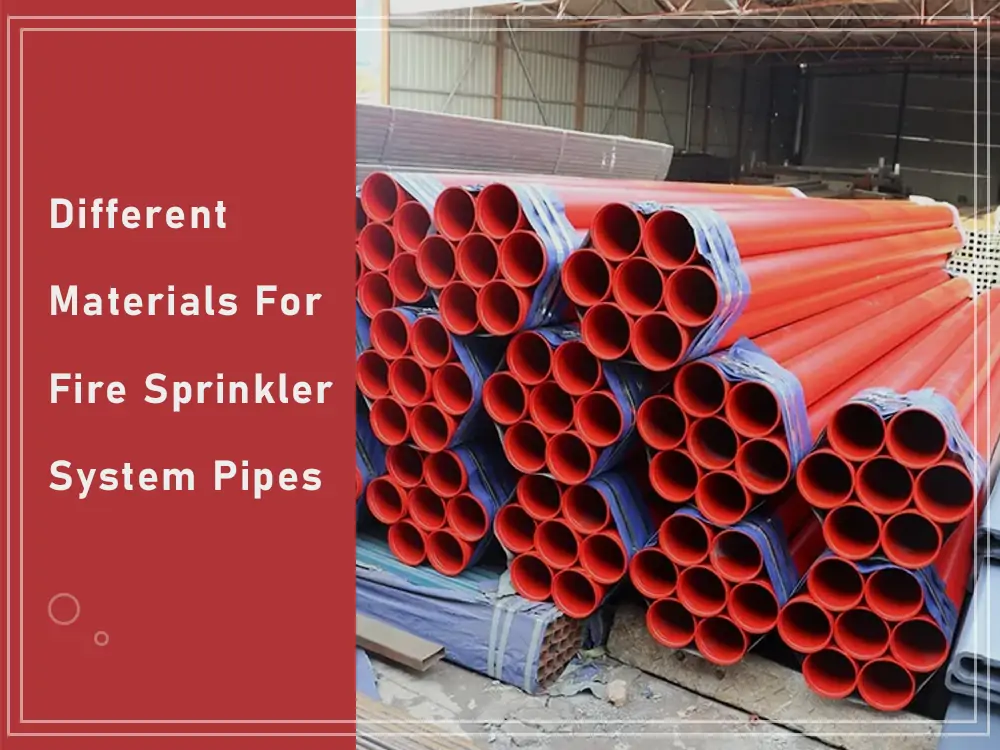
Введение
При установке спринклерной системы пожаротушения компании должны оценить такие качества материала труб, как высокая прочность, высокая температура плавления и устойчивость к ржавчине. Американское общество по испытаниям и материалам (ASTM) разработало определенные стандарты для этих материалов. Материал труб, отвечающий этим стандартам, - это подходящая труба, которая будет оставаться целой и не подвергаться протечкам. Выбор трубы обеспечивает надежность и долговечность системы. Для монтажа спринклерной системы пожаротушения обычно используются стальные и медные трубы, которые имеют эпоксидное покрытие, делающее трубу более устойчивой в суровых условиях. При монтаже системы используются различные виды материалов для спринклерных труб. Вот названия всех видов.
Стальная труба
- Труба из углеродистой стали
- Оцинкованная стальная труба
- Черная стальная труба
- Труба из нержавеющей стали
- Труба из легированной стали
Медная труба
Труба из ХПВХ/ПВХ
Железная труба
Ниже приведены подробные сведения о каждом материале труб:
1. Стальная труба
Стальные трубы пригодятся для этой цели, поскольку они имеют высокую температуру плавления 1400°C-1500°C, что очень важно для спринклерной системы пожаротушения. Точка устойчивости к коррозии для стальных труб составляет около 120C. Поскольку известно, что это система безопасности, которая срабатывает при появлении дыма или огня, фитинги и соединения в трубах должны быть выполнены очень точно, чтобы не было утечек. Критерии стали повышаются за счет добавления других металлов для улучшения ее свойств.
a) Трубы из углеродистой стали
Стальные трубы с углеродом в качестве сплава известны как трубы из углеродистой стали. Они содержат от 0,05% до 2,5% углерода. Низко- и высокоуглеродистая сталь имеет температуру плавления 1400, а высокоуглеродистая - до 1580. Углерод придает стали прочность и способность выдерживать давление воды в случае включения системы. Люди используют трубы из углеродистой стали в своих коммерческих и жилых зданиях, которые обеспечивают защиту и высокую производительность, необходимые для спринклерных систем пожаротушения.
б) Оцинкованная стальная труба
Гальванизация - это процесс, в ходе которого стальные листы покрываются другими материалами. На поверхность стали наносится слой цинка. Стальные листы погружаются в расплавленный цинк, который образует химическую связь со слоем стали. Это повышает прочность стальных труб или листов на разрыв до 510-600 МПа. Цинковое покрытие обеспечивает дополнительную устойчивость к воспламенению, реакционной способности и токсичности. Со временем этот слой обычно разрушается, что делает сталь более склонной к ржавчине.
в) Черная стальная труба
Компании должны знать, что предпочтительным видом стали для спринклерных труб является черная сталь. В черной стали высокое содержание углерода - 0,25% и марганца - от 0,95% до 1,44%. Сочетание углерода и марганца делает стальные трубы более прочными. Устойчивость к ржавчине составляет очень высокий коэффициент 120С, а температура плавления - 1400-1580 градусов. Коэффициент теплового расширения составляет всего 0,63 дюйма, а это значит, что при нагревании до высоких температур размер трубы из черной стали остается прежним.
г) Труба из нержавеющей стали
Из сплавов хрома и никеля изготавливают трубы из нержавеющей стали. Все категории стальных труб очень жесткие, с очень низкой гибкостью для таких размеров, как 3,7. Нержавеющая сталь не отличается гибкостью, прочностью и устойчивостью к ржавчине. Трубы из нержавеющей стали устанавливаются в местах, где они подвергаются воздействию ультрафиолетовых лучей, которые не нарушают их химический состав. Они являются предпочтительным выбором для спринклерных систем пожаротушения.
д) Трубы из легированной стали
Добавление в стальные трубы различных материалов, таких как хром, молибден и никель, повышает их прочность и устойчивость к ржавчине. Эти трубы устанавливаются в спринклерной системе пожаротушения, где условия эксплуатации экстремальные, а давление высокое.
2. Медная труба
Медные спринклерные трубы довольно дороги, но они являются экономически эффективным решением для системы после установки. Коэффициент гибкости 2,4 делает медь более гибкой, чем сталь. Температура плавления меди составляет около 1000 градусов Цельсия, что очень мало по сравнению со стальными трубами. Медь имеет высокое значение коэффициента 150C для устойчивости к ржавчине, поэтому нет необходимости в частом обслуживании. Изменение размеров под воздействием тепла для меди составляет около 1,4-1,5 дюйма.
3. Трубы из ХПВХ/ПВХ
С развитием технологий все большее предпочтение в каждой отрасли отдается трубам из ПВХ. Люди, занятые в бизнесе, знают, что трубы из поливинилхлорида очень просты в установке и очень экономичны по сравнению с другими стальными трубами. ПВХ имеет очень низкую температуру плавления - 100-120 градусов Цельсия. Трубы из ПВХ имеют множество преимуществ, но не могут выдержать давление и температуру воды, используемой в процессе спринклерного полива.
4. Железная труба
Чугун и ковкий чугун - два вида железных труб, которые используются в спринклерных системах пожаротушения. Эти два вида чугуна имеют разные температуры плавления и коррозионную стойкость. Чугунные трубы использовались в спринклерной системе с древних времен благодаря их способности выдерживать давление и температуру. С другой стороны, гибкость и прочность ковкого чугуна делают их подходящими для участков, требующих значительных изгибов.
Какой тип труб лучше всего подходит для спринклерных систем пожаротушения?
Почти 70% коммерческих и жилых проектов для спринклерной системы пожаротушения обычно выходят из строя через 12-13 лет. Коррозия материалов является основной проблемой для этих систем. Предпочтительнее выбирать материалы с высокой температурой плавления. Так, трубы из черной стали являются наиболее подходящим вариантом для спринклерной системы пожаротушения, поскольку эти трубы имеют низкую стоимость, высокую прочность, самые высокие температуры плавления и высокую коррозионную стойкость.
